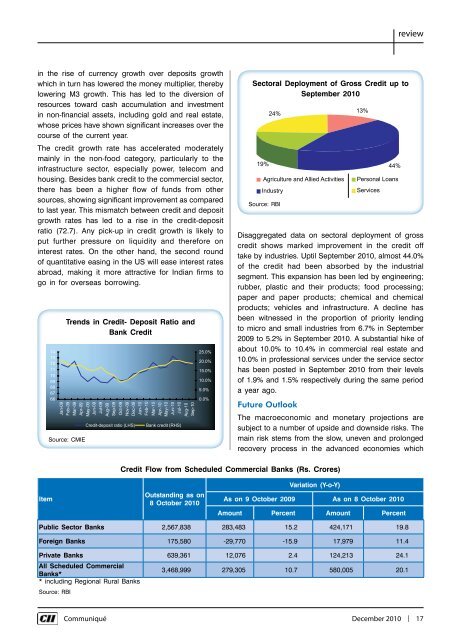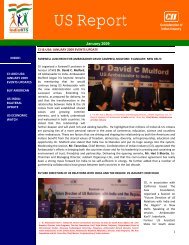CII Communique - December, 2010
CII Communique - December, 2010
CII Communique - December, 2010
You also want an ePaper? Increase the reach of your titles
YUMPU automatically turns print PDFs into web optimized ePapers that Google loves.
eview<br />
in the rise of currency growth over deposits growth<br />
which in turn has lowered the money multiplier, thereby<br />
lowering M3 growth. This has led to the diversion of<br />
resources toward cash accumulation and investment<br />
in non-financial assets, including gold and real estate,<br />
whose prices have shown significant increases over the<br />
course of the current year.<br />
The credit growth rate has accelerated moderately<br />
mainly in the non-food category, particularly to the<br />
infrastructure sector, especially power, telecom and<br />
housing. Besides bank credit to the commercial sector,<br />
there has been a higher flow of funds from other<br />
sources, showing significant improvement as compared<br />
to last year. This mismatch between credit and deposit<br />
growth rates has led to a rise in the credit-deposit<br />
ratio (72.7). Any pick-up in credit growth is likely to<br />
put further pressure on liquidity and therefore on<br />
interest rates. On the other hand, the second round<br />
of quantitative easing in the US will ease interest rates<br />
abroad, making it more attractive for Indian firms to<br />
go in for overseas borrowing.<br />
Trends in Credit- Deposit Ratio and<br />
Bank Credit<br />
Source: CMIE<br />
Sectoral Deployment of Gross Credit up to<br />
September <strong>2010</strong><br />
Source: RBI<br />
Disaggregated data on sectoral deployment of gross<br />
credit shows marked improvement in the credit off<br />
take by industries. Uptil September <strong>2010</strong>, almost 44.0%<br />
of the credit had been absorbed by the industrial<br />
segment. This expansion has been led by engineering;<br />
rubber, plastic and their products; food processing;<br />
paper and paper products; chemical and chemical<br />
products; vehicles and infrastructure. A decline has<br />
been witnessed in the proportion of priority lending<br />
to micro and small industries from 6.7% in September<br />
2009 to 5.2% in September <strong>2010</strong>. A substantial hike of<br />
about 10.0% to 10.4% in commercial real estate and<br />
10.0% in professional services under the service sector<br />
has been posted in September <strong>2010</strong> from their levels<br />
of 1.9% and 1.5% respectively during the same period<br />
a year ago.<br />
Future Outlook<br />
The macroeconomic and monetary projections are<br />
subject to a number of upside and downside risks. The<br />
main risk stems from the slow, uneven and prolonged<br />
recovery process in the advanced economies which<br />
Credit Flow from Scheduled Commercial Banks (Rs. Crores)<br />
Item<br />
Outstanding as on<br />
8 October <strong>2010</strong><br />
Variation (Y-o-Y)<br />
As on 9 October 2009 As on 8 October <strong>2010</strong><br />
Amount Percent Amount Percent<br />
Public Sector Banks 2,567,838 283,483 15.2 424,171 19.8<br />
Foreign Banks 175,580 -29,770 -15.9 17,979 11.4<br />
Private Banks 639,361 12,076 2.4 124,213 24.1<br />
All Scheduled Commercial<br />
Banks*<br />
3,468,999 279,305 10.7 580,005 20.1<br />
* including Regional Rural Banks<br />
Source: RBI<br />
Communiqué <strong>December</strong> <strong>2010</strong> | 17

















